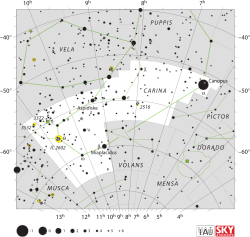Theta Carinae

Location of θ Carinae (circled) | |
| Observation data Epoch J2000.0 Equinox J2000.0 | |
|---|---|
| Constellation | Carina |
| Right ascension | 10h 42m 57.40197s[1] |
| Declination | –64° 23′ 40.0208″[1] |
| Apparent magnitude (V) | 2.76[2] |
| Characteristics | |
| Spectral type | B0.5 Vp[3] |
| U−B color index | –1.00[2] |
| B−V color index | –0.22[2] |
| Astrometry | |
| Radial velocity (Rv) | +24[4] km/s |
| Proper motion (μ) | RA: –18.36[1] mas/yr Dec.: +12.03[1] mas/yr |
| Parallax (π) | 7.16 ± 0.21[1] mas |
| Distance | 460 ± 10 ly (140 ± 4 pc) |
| Orbit[5] | |
| Period (P) | 2.20288 ± 0.00001 d |
| Eccentricity (e) | 0.129 ± 0.002 |
| Argument of periastron (ω) (secondary) | 81.8 ± 1.7° |
| Semi-amplitude (K1) (primary) | 18.93 ± 0.05 km/s |
| Details | |
| θ Car A | |
| Mass | 14.9 ± 0.4[6] M☉ |
| Radius | 5.1[5] R☉ |
| Luminosity | 25,673[7] L☉ |
| Surface gravity (log g) | 4.20[8] cgs |
| Temperature | 31,000[8] K |
| Rotational velocity (v sin i) | 108 ± 3[8] km/s |
| Age | 4.0 ± 0.7[6] Myr |
| Other designations | |
Theta Carinae (θ Car, θ Carinae) is a star in the southern constellation of Carina. With an apparent visual magnitude of 2.76,[2] it is the brightest star in the open star cluster IC 2602. It marks the northeastern end of the Diamond Cross asterism. Parallax measurements from the Hipparcos mission place this star at a distance of about 460 light-years (140 parsecs) from Earth.
In Chinese, 南船 (Nán Chuán), meaning Southern Boat, refers to an asterism consisting of θ Carinae, V337 Carinae, PP Carinae, β Carinae and ω Carinae.[10] Consequently, θ Carinae itself is known as 南船三 (Nán Chuán sān, English: the Third Star of Southern Boat.)[11]
The stellar classification of this star is B0.5 Vp,[3] which indicates this is a B-type main sequence star that is generating energy at its core through the nuclear fusion of hydrogen. The 'p' suffix means it displays peculiar features in its spectrum, which have been observed in both the optical and ultraviolet band. This might be explained by a magnetic field, yet no such measurable field has been observed. Theta Carinae is actually a single-lined spectroscopic binary with a period of 2.2 days; the shortest known orbital period among massive stars. The close orbit means that a mass transfer between the two components may have occurred, which could explain the peculiarities of the spectrum.[5]
The primary component in this system is a blue straggler, which is a type of star that is created by the interaction between two or more stars. Most likely the source of this mass transfer was the secondary member of the system, and what is now the primary star was probably once the secondary component. At an estimated age of 4 million years,[6] this star is much younger than the age of the surrounding IC 2602 cluster, which is consistent with it being a straggler. At present the primary star has about 15[6] times the mass of the Sun and five[5] times the Sun's radius. It has an intensely hot outer envelope that is radiating more than 25,000[7] the Sun's luminosity at an effective temperature of 31,000 K,[8] giving it a blue-white glow.[12] When the primary reaches the age of around 11 million years, it will expand to the point where it will begin to transfer part of its mass back to its companion. Little is known about this secondary component, but it may be an F-type star with a luminosity less than 1% of the primary.[5]
References
- ↑ 1.0 1.1 1.2 1.3 1.4 van Leeuwen, F. (November 2007), "Validation of the new Hipparcos reduction", Astronomy and Astrophysics 474 (2): 653–664, arXiv:0708.1752, Bibcode:2007A&A...474..653V, doi:10.1051/0004-6361:20078357
- ↑ 2.0 2.1 2.2 2.3 Johnson, H. L. et al. (1966), "UBVRIJKL photometry of the bright stars", Communications of the Lunar and Planetary Laboratory 4 (99), Bibcode:1966CoLPL...4...99J
- ↑ 3.0 3.1 Houk, Nancy (1978), Michigan catalogue of two-dimensional spectral types for the HD stars 1, Ann Arbor: Dept. of Astronomy, University of Michigan, Bibcode:1975mcts.book.....H
- ↑ Evans, D. S. (June 20–24, 1966), "The Revision of the General Catalogue of Radial Velocities", in Batten, Alan Henry; Heard, John Frederick, Determination of Radial Velocities and their Applications, Proceedings from IAU Symposium no. 30, University of Toronto: International Astronomical Union, Bibcode:1967IAUS...30...57E
- ↑ 5.0 5.1 5.2 5.3 5.4 Hubrig, S. et al. (September 2008), "New insights into the nature of the peculiar star θ Carinae", Astronomy and Astrophysics 488 (1): 287–296, arXiv:0807.2067, Bibcode:2008A&A...488..287H, doi:10.1051/0004-6361:200809972
- ↑ 6.0 6.1 6.2 6.3 Tetzlaff, N.; Neuhäuser, R.; Hohle, M. M. (January 2011), "A catalogue of young runaway Hipparcos stars within 3 kpc from the Sun", Monthly Notices of the Royal Astronomical Society 410 (1): 190–200, arXiv:1007.4883, Bibcode:2011MNRAS.410..190T, doi:10.1111/j.1365-2966.2010.17434.x
- ↑ 7.0 7.1 Hohle, M. M.; Neuhäuser, R.; Schutz, B. F. (April 2010), "Masses and luminosities of O- and B-type stars and red supergiants", Astronomische Nachrichten 331 (4): 349, arXiv:1003.2335, Bibcode:2010AN....331..349H, doi:10.1002/asna.200911355
- ↑ 8.0 8.1 8.2 8.3 Lefever, K. et al. (June 2010), "Spectroscopic determination of the fundamental parameters of 66 B-type stars in the field-of-view of the CoRoT satellite", Astronomy and Astrophysics 515: A74, arXiv:0910.2851, Bibcode:2010A&A...515A..74L, doi:10.1051/0004-6361/200911956
- ↑ "tet Car -- Spectroscopic binary", SIMBAD Astronomical Object Database (Centre de Données astronomiques de Strasbourg), retrieved 2012-02-16
- ↑ (Chinese) 中國星座神話, written by 陳久金. Published by 台灣書房出版有限公司, 2005, ISBN 978-986-7332-25-7.
- ↑ (Chinese) AEEA (Activities of Exhibition and Education in Astronomy) 天文教育資訊網 2006 年 7 月 28 日
- ↑ "The Colour of Stars", Australia Telescope, Outreach and Education (Commonwealth Scientific and Industrial Research Organisation), December 21, 2004, retrieved 2012-01-16
External links
| ||||||||||||||||||||